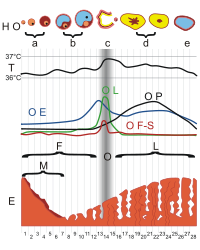
Photo from wikipedia
ABSTRACT The purpose of this study was to further our understanding of early childhood pain-related distress regulation. Concurrent and predictive relations between child-led emotion regulation (ER) behaviors and pain-related distress… Click to show full abstract
ABSTRACT The purpose of this study was to further our understanding of early childhood pain-related distress regulation. Concurrent and predictive relations between child-led emotion regulation (ER) behaviors and pain-related distress during vaccination were examined at 2 different ages using autoregressive cross-lagged path analyses. Toddlers were video-recorded at the 12- and 18-month routine vaccination appointments (12-month-old [N = 163]; 18-month-old [N = 149]). At 1, 2, and 3 minutes postneedle, videos were coded for 3 clusters of child-led ER behaviors (disengagement of attention, parent-focused behaviors, and physical self-soothing) and pain-related distress. The concurrent and predictive relations between child-led ER behaviors and pain-related distress behaviors were assessed using 6 models (3 emotion regulation behaviors by 2 ages). At 18 months, disengagement of attention was significantly negatively related to pain-related distress at 1 minute postneedle, and pain-related distress at 1 minute postneedle was significantly related to less disengagement of attention at 2 minutes postneedle. Parent-focused behaviors had significant positive relations with pain-related distress at both ages, with stronger magnitudes at 18 months. Physical self-soothing was significantly related to less pain-related distress at both ages. Taken together, these findings suggest that disengagement of attention and physical self-soothing may serve more of a regulatory function during toddlerhood, whereas parent-focused behaviors may serve more of a function of gaining parent support for regulation. This study is the first to assess these relations during routine vaccination in toddlerhood and suggests that toddlers in the second year of life are beginning to play a bigger role in their own regulation from painful procedures than earlier in infancy.
Journal Title: Pain
Year Published: 2022
Link to full text (if available)
Share on Social Media: Sign Up to like & get
recommendations!